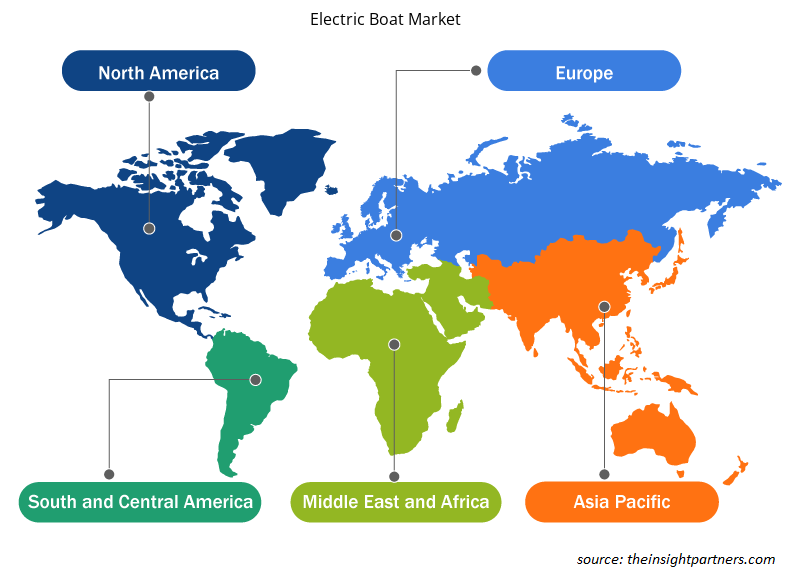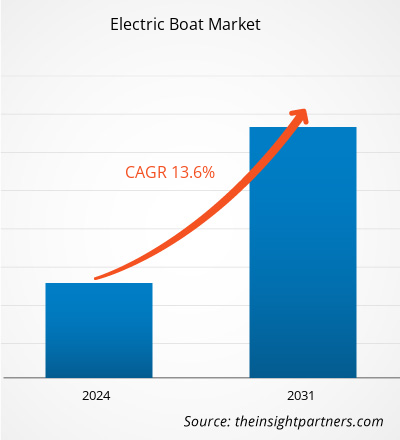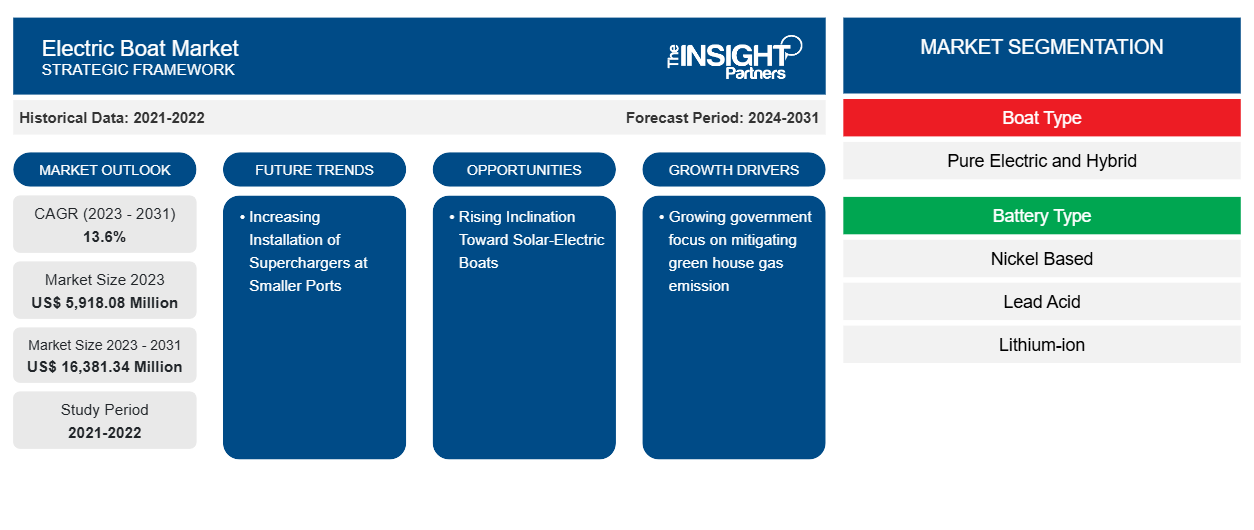Der Markt für Elektroboote soll von 5.918,08 Millionen US-Dollar im Jahr 2023 auf 16.381,34 Millionen US-Dollar im Jahr 2031 anwachsen. Der Markt wird zwischen 2023 und 2031 voraussichtlich eine durchschnittliche jährliche Wachstumsrate (CAGR) von 13,6 % verzeichnen. Die zunehmende Installation von Kompressoren in kleineren Häfen dürfte ein wichtiger Trend auf dem Markt bleiben.
Marktanalyse für Elektroboote
Hersteller von Elektrobooten konzentrieren sich zunehmend darauf, die Batterieeffizienz und Reichweite durch die Verbesserung der Ladeinfrastruktur zu verbessern. Die große Zahl von Herstellern von Elektrobooten steht in großem Maßstab im Wettbewerb, hauptsächlich auf der Grundlage der Ladetechnologie (Funktionen) und der weltweiten Verfügbarkeit. Dazu gehören Candela, Frauscher, Duffy Electric Boat Company und andere Akteure.
Marktübersicht für Elektroboote
Zu den wichtigsten Interessenvertretern im Ökosystem des globalen Marktes für Elektroboote gehören Rohstofflieferanten, Komponentenlieferanten und Kunden oder Endnutzer. Der Rohstofflieferant ist ein entscheidender Interessenvertreter im Ökosystem des Marktes für Elektroboote. Die Hauptteile des Elektroboots bestehen unter anderem aus Kunststoff, Stahl, Aluminium, Holz, Gummi. Zu den Komponentenlieferanten gehören Hersteller von Schiffsteilen und Ladegeräteanbieter. Die wichtigsten Endnutzer, die Elektroboote nachfragen, sind Bootsbesitzer und Bootsverleiher. Zu den wichtigsten Rohstofflieferanten gehören Duffy Electric Boat Company, Evoy, RAND Boats und andere Akteure.
Passen Sie diesen Bericht Ihren Anforderungen an
Sie erhalten kostenlos individuelle Anpassungen an jedem Bericht, einschließlich Teilen dieses Berichts oder einer Analyse auf Länderebene, eines Excel-Datenpakets sowie tolle Angebote und Rabatte für Start-ups und Universitäten.
- Holen Sie sich die wichtigsten Markttrends aus diesem Bericht.Dieses KOSTENLOSE Beispiel umfasst eine Datenanalyse von Markttrends bis hin zu Schätzungen und Prognosen.
Treiber und Chancen auf dem Elektrobootmarkt
Wachsender Fokus der Regierung auf die Reduzierung von Treibhausgasemissionen begünstigt den Markt
Die zunehmende Umweltverschmutzung durch fossile Brennstoffe ist eines der größten Anliegen der Regierung. Um das Ausmaß der Umweltverschmutzung zu reduzieren, legen verschiedene Regierungen Wert darauf, dass die Verbraucher sauberere, nachhaltigere und umweltfreundlichere Alternativen wählen, indem sie spezielle Rabatte auf Verkäufe, Anreize, lukrative Angebote und Steuervorteile gewähren. China, Japan, die Europäische Union, Indien, Kanada und Südkorea sind einige der wichtigsten Regionen, in denen die Regierungen aktiv daran arbeiten, die Einführung von Elektrobooten zu fördern, was die Entwicklung des Elektrobootmarktes im Prognosezeitraum voraussichtlich vorantreiben wird. Der zunehmende Fokus auf die Reduzierung von Treibhausgasemissionen wirkt sich auch als wichtiger Wachstumstreiber für den Elektrobootmarkt weltweit aus.
Steigende Tendenz zu solarbetriebenen Booten
Solarbetriebene Boote haben mehrere Vorteile, darunter einen geringen Wartungsaufwand, da kein Öl- oder Dieselfilterwechsel erforderlich ist, weniger Vibrationen, einen guten Kraftstoffverbrauch, die Vermeidung lokaler Verschmutzung und eine Verringerung des Gesamtgewichts des Bootes. Solarenergie unterstützt die Steuerung des Stromflusses zu wiederaufladbaren Batterien wie Lithium-Ionen -Batterien . Darüber hinaus können solarbetriebene Boote mit geringen Betriebskosten betrieben werden, was sie für Benutzer zur bevorzugten Option im Vergleich zu brennstoffbetriebenen Booten macht, bei denen ein hoher Bedarf an regelmäßiger Wartung besteht. Diese Vorteile werden voraussichtlich die Nachfrage nach solarbetriebenen Booten in den kommenden Jahren verstärken.
Segmentierungsanalyse des Marktberichts für Elektroboote
Wichtige Segmente, die zur Ableitung der Marktanalyse für Elektroboote beigetragen haben, sind Bootstyp, Batterietyp und Anwendung.
- Basierend auf dem Bootstyp ist der Markt für Elektroboote in reine Elektro- und Hybridboote unterteilt. Das Segment der reinen Elektroboote hatte im Jahr 2023 einen größeren Marktanteil.
- Basierend auf dem Batterietyp ist der Markt für Elektroboote in Nickel-basierte, Blei-Säure- und Lithium-Ionen-Batterien unterteilt. Das Lithium-Ionen-Segment hatte im Jahr 2023 einen größeren Marktanteil.
- Basierend auf der Anwendung ist der Markt für Elektroboote in Angeln, Freizeit und Sonstiges unterteilt. Das Freizeitsegment hatte im Jahr 2023 einen größeren Marktanteil.
Marktanteilsanalyse für Elektroboote nach geografischer Lage
Der geografische Umfang des Marktberichts für Elektroboote ist hauptsächlich in fünf Regionen unterteilt: Nordamerika, Asien-Pazifik, Europa, Naher Osten und Afrika sowie Süd- und Mittelamerika.
Der Umfang des Marktberichts für Elektroboote umfasst Nordamerika (USA, Kanada und Mexiko), Europa (Russland, Großbritannien, Frankreich, Deutschland, Italien und den Rest Europas), den asiatisch-pazifischen Raum (Südkorea, Indien, Australien, Japan, China und den Rest des asiatisch-pazifischen Raums), den Nahen Osten und Afrika (Saudi-Arabien, Südafrika, die Vereinigten Arabischen Emirate und den Rest des Nahen Ostens und Afrikas) sowie Süd- und Mittelamerika (Argentinien, Brasilien und den Rest Süd- und Mittelamerikas). In Bezug auf den Umsatz dominierte Nordamerika den Marktanteil von Elektrobooten im Jahr 2023. Europa ist der zweitgrößte Beitragszahler zum globalen Markt für Elektroboote, gefolgt vom asiatisch-pazifischen Raum.UAE, and the Rest of Middle East & Africa), and South & Central America (Argentina, Brazil, and the Rest of South & Central America). In terms of revenue, North America dominated the electric boat market share in 2023. Europe is the second-largest contributor to the global electric boat market, followed by Asia Pacific.
Regionale Einblicke in den Markt für Elektroboote
Die regionalen Trends und Faktoren, die den Markt für Elektroboote im Prognosezeitraum beeinflussen, wurden von den Analysten von Insight Partners ausführlich erläutert. In diesem Abschnitt werden auch die Marktsegmente und die Geografie des Marktes für Elektroboote in Nordamerika, Europa, im asiatisch-pazifischen Raum, im Nahen Osten und Afrika sowie in Süd- und Mittelamerika erörtert.

- Erhalten Sie regionale Daten zum Markt für Elektroboote
Umfang des Marktberichts für Elektroboote
| Berichtsattribut | Details |
|---|---|
| Marktgröße im Jahr 2023 | 5.918,08 Millionen US-Dollar |
| Marktgröße bis 2031 | 16.381,34 Millionen US-Dollar |
| Globale CAGR (2023 - 2031) | 13,6 % |
| Historische Daten | 2021-2022 |
| Prognosezeitraum | 2024–2031 |
| Abgedeckte Segmente | Nach Bootstyp
|
| Abgedeckte Regionen und Länder | Nordamerika
|
| Marktführer und wichtige Unternehmensprofile |
|
Dichte der Marktteilnehmer für Elektroboote: Auswirkungen auf die Geschäftsdynamik verstehen
Der Markt für Elektroboote wächst rasant, angetrieben durch die steigende Nachfrage der Endnutzer aufgrund von Faktoren wie sich entwickelnden Verbraucherpräferenzen, technologischen Fortschritten und einem größeren Bewusstsein für die Vorteile des Produkts. Mit steigender Nachfrage erweitern Unternehmen ihr Angebot, entwickeln Innovationen, um die Bedürfnisse der Verbraucher zu erfüllen, und nutzen neue Trends, was das Marktwachstum weiter ankurbelt.
Die Marktteilnehmerdichte bezieht sich auf die Verteilung der Firmen oder Unternehmen, die in einem bestimmten Markt oder einer bestimmten Branche tätig sind. Sie gibt an, wie viele Wettbewerber (Marktteilnehmer) in einem bestimmten Marktraum im Verhältnis zu seiner Größe oder seinem gesamten Marktwert präsent sind.
Die wichtigsten auf dem Markt für Elektroboote tätigen Unternehmen sind:
- Frauscher Bootswerft GmbH & Co KG
- Duffy Elektroboot Co
- Rand Boats A/S
- Vision Marine Technologies Inc.
- Quadrofoil doo
- Budsin Holzhandwerk
Haftungsausschluss : Die oben aufgeführten Unternehmen sind nicht in einer bestimmten Reihenfolge aufgeführt.

- Überblick über die wichtigsten Akteure auf dem Markt für Elektroboote
Neuigkeiten und aktuelle Entwicklungen zum Markt für Elektroboote
Der Markt für Elektroboote wird durch die Erhebung qualitativer und quantitativer Daten nach Primär- und Sekundärforschung bewertet, die wichtige Unternehmensveröffentlichungen, Verbandsdaten und Datenbanken umfasst. Nachfolgend sind einige der Entwicklungen auf dem Markt für Elektroboote aufgeführt:
- Der dänische Bootsbauer Rand Boats A/S hat ein neues elektrisches Sportboot namens Spirit 25 vorgestellt, das auch in einer benzinbetriebenen Version erhältlich ist. (Quelle: Rand Boats A/S, Pressemitteilung, März 2022)
- Die Groupe Beneteau hat sich mit Vision Marine Technologies zusammengetan, um Boote zu entwickeln, die vollelektrisch mit Außenbordmotoren ausgestattet sind. (Quelle: Vision Marine Technologies, Pressemitteilung, Juli 2022)
Marktbericht zum Thema Elektroboote – Abdeckung und Ergebnisse
Der Bericht „Marktgröße und Prognose für Elektroboote (2021–2031)“ bietet eine detaillierte Analyse des Marktes, die die folgenden Bereiche abdeckt:
- Marktgröße und Prognose für Elektroboote auf globaler, regionaler und Länderebene für alle wichtigen Marktsegmente, die im Rahmen des Berichts abgedeckt sind
- Markttrends für Elektroboote sowie Marktdynamik wie Treiber, Einschränkungen und wichtige Chancen
- Detaillierte PEST- und SWOT-Analyse
- Marktanalyse für Elektroboote mit wichtigen Markttrends, globalen und regionalen Rahmenbedingungen, wichtigen Akteuren, Vorschriften und aktuellen Marktentwicklungen
- Branchenlandschaft und Wettbewerbsanalyse, einschließlich Marktkonzentration, Heatmap-Analyse, prominenten Akteuren und aktuellen Entwicklungen für den Markt für Elektroboote
- Detaillierte Firmenprofile
- Historische Analyse (2 Jahre), Basisjahr, Prognose (7 Jahre) mit CAGR
- PEST- und SWOT-Analyse
- Marktgröße Wert/Volumen – Global, Regional, Land
- Branchen- und Wettbewerbslandschaft
- Excel-Datensatz
Aktuelle Berichte
Verwandte Berichte
Erfahrungsberichte
Grund zum Kauf
- Fundierte Entscheidungsfindung
- Marktdynamik verstehen
- Wettbewerbsanalyse
- Kundeneinblicke
- Marktprognosen
- Risikominimierung
- Strategische Planung
- Investitionsbegründung
- Identifizierung neuer Märkte
- Verbesserung von Marketingstrategien
- Steigerung der Betriebseffizienz
- Anpassung an regulatorische Trends





















 Kostenlose Probe anfordern für - Markt für Elektroboote
Kostenlose Probe anfordern für - Markt für Elektroboote